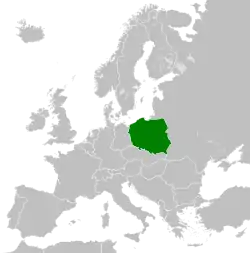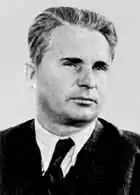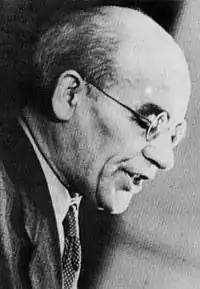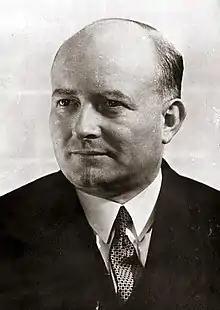Provisional Government of National Unity
The Provisional Government of National Unity (Polish: Tymczasowy Rząd Jedności Narodowej or TRJN) was a government formed by the decree of the State National Council (Krajowa Rada Narodowa, KRN) on 28 June 1945. It was created as a coalition between the Polish Workers' Party (Polska Partia Robotnicza, PPR; Soviet-backed) and politicians from close political sphere of Stanisław Mikołajczyk, former Prime Minister of the Polish government-in-exile based in London.
Republic of Poland Rzeczpospolita Polska | |||||||||||||
|---|---|---|---|---|---|---|---|---|---|---|---|---|---|
| 1945–1947 | |||||||||||||
.svg.png.webp) Flag
| |||||||||||||
 Polish People's Republic during Cold War | |||||||||||||
| Status | Satellite state of the Soviet Union | ||||||||||||
| Capital | Warsaw (de jure) Łódź (de facto) | ||||||||||||
| Common languages | Polish (official) Silesian, Kashubian, German | ||||||||||||
| Religion | Catholic | ||||||||||||
| Demonym(s) | Pole, Polish | ||||||||||||
| Government | Unitary Marxist–Leninist provisional government | ||||||||||||
| President of KRN | |||||||||||||
• 1945–1947 | Bolesław Bierut | ||||||||||||
| Prime Minister | |||||||||||||
• 1945–1947 | E. Osóbka-Morawski | ||||||||||||
| History | |||||||||||||
• Establishment | 28 June 1945 | ||||||||||||
• Admitted to the UN | 24 October 1945 | ||||||||||||
| 19 January 1947 | |||||||||||||
| Area | |||||||||||||
| 1946 | 312,685 km2 (120,728 sq mi) | ||||||||||||
| Population | |||||||||||||
• 1946 | 23,930,000 | ||||||||||||
| Currency | Polish złoty | ||||||||||||
| |||||||||||||
| Today part of | |||||||||||||
Background



When Poland was conquered by Germany in 1939, members of the government escaped to Britain, where they established a government-in-exile, which was recognized by the British government, and controlled the main Polish resistance force, the Armia Krajowa (Home Army).
In 1943, the PPR and some other left-wing resistance groups formed the KRN as a national government of Poland, in rivalry to the exile government. In July 1944, the KRN proclaimed the Provisional Government of the Republic of Poland (the "Lublin Committee") in territory liberated from Germany by the Soviet Army. The exile government denounced this, but was powerless to interfere, especially after the Armia Krajowa was largely destroyed in the 1944 Warsaw Uprising.
The exile government was dependent on the support of the British and American governments, which did not grasp Communist intentions and pressured the exile government to cooperate with the KRN. By the time of the Yalta Conference in February 1945, Soviet forces had overrun nearly all of Poland, giving them and the KRN effective control. The US and Britain tacitly accepted this at Yalta, in return for Stalin's promise of free elections in Poland.
The Polish exile government still tried to hold out, but was ignored. A group including Stanisław Mikołajczyk, Prime Minister in 1943-1944, broke with the rest of the exiles and began seeking a deal with the Communists.
Establishment
The TRJN was a result of negotiations held in Moscow from 17 June to 21 June 1945, between the PPR (Polish Communists), the Soviet Union, and Mikołajczyk, who had created the Polish People's Party (Polskie Stronnictwo Ludowe, PSL) as the political vehicle for his participation. The PSL was a centrist organization and continuation of the prewar Polish agrarian movement. The pre-war People's Party also supported Mikołajczyk.
The TRJN government was composed of:
- Prime Minister: Edward Osóbka-Morawski (Polish Socialist Party)
- Deputy Prime Minister, Minister of Regained Territories: Władysław Gomułka (PPR)
- Deputy Prime Minister, Minister of Agriculture and Agricultural Reform: Stanisław Mikołajczyk (PSL)
The entire government was composed of:
- PPR: 7 ministers
- Socialist Party: 6 ministers
- People's Party: 3 ministers
- PSL: 3 ministers
- Democratic Party: 2 ministers
The exile government did not recognize the TRJN.[1]
Subsequent events
The Communists had no intention of giving the opposition any real power, or carrying out the promised 'free and fair' elections. The members of the opposition that received government positions were kept in check by their deputies and staff, loyal to the Communists, so they had little real power.
On 21 June, General Leopold Okulicki, former Commander of the Polish Home Army was sentenced to 10 years of imprisonment in Moscow for the alleged sabotage against the Soviet Army. Ten other Poles were given similar sentences in the staged Trial of the Sixteen. On 24 December 1946, Okulicki died in Butyrka prison.
The TRJN was already bound by the "Treaty of Friendship, Mutual Help, and Cooperation" with the USSR which the Provisional Government had signed on 21 April. This treaty formed the basis for Soviet interference in Poland's internal politics for the next 40 years.
On 5 July 1945, the TRJN was recognized by the United States. It was soon also recognized by the other major Allies, France and the United Kingdom. It was not recognized by the Vatican.
On 6 July, while the Polish government-in-exile maintained its existence, both the United States and the United Kingdom formally withdrew the recognition of it.
On 10 July, Osóbka-Morawski announced the expulsion of all Germans from Poland.
From 17 July to 2 August, a delegation from the TRJN attended the 1945 Potsdam Conference.
On 16 August, a Soviet-Polish border agreement was signed in Moscow. Before the end of August, Poland agreed to cede the eastern provinces to the Soviet Union and officially recognized the eastern border based on a slightly modified Curzon line.
On 16 October, delegates of the TRJN signed the United Nations Charter and Poland became a member of the United Nations.
The 'free and fair' elections promised by the TRJN were postponed until the Communists were sure they could control the election process. In the meantime, they increased repressions of opposition members, who were bribed, threatened, delegalised, or even murdered. In the words of Gomułka, the goal of the Communists was to be the "hegemon of the nation" and nothing would stop them. On 30 June 1946, they tested their control during the 3xTAK referendum, falsifying the results and claiming 68% support.
Two great reforms carried out by TRJN were the nationalization decree and the Three-Year Plan (of 1947–49), both issued in 1946. The nationalization decree gave the government control over every enterprise which employed more than 50 people; by the end of the year, 90% of the country's industry was controlled by the government.
Dissolution
The Communists rigged the Polish legislative elections of January 1947. The new parliament (Sejm Ustawodawczy) replaced the KRN; it named a new government headed by Józef Cyrankiewicz. On 19 January 1947, TRJN was dissolved and passed its prerogatives as the government of Poland to the new government.
See also
- Polish Committee of National Liberation (Polish: Polski Komitet Wyzwolenia Narodowego; PKWN) - 1944 and 1945
- Provisional Government of the Republic of Poland (Polish: Rząd Tymczasowy Rzeczypospolitej Polskiej; RTRP) - 1945
- Polish People's Party (1945–49)
- People's Republic of Poland (Polish: Polska Rzeczpospolita Ludowa; PRL) - 1944 to 1952 (unofficially), 1952 to 1989 (officially)
- People's Army of Poland (Polish: Ludowe Wojsko Polskie; LWP)
- Polish government-in-exile
References
- Peter Stachura The Poles in Britain 1940-2000 ISBN 0-7146-8444-9 Page 7
Further reading
- Davies, Norman, 1982 and several reprints. God's Playground. 2 vols. New York: Columbia Univ. Press. ISBN 0-231-05353-3 and ISBN 0-231-05351-7
.svg.png.webp)